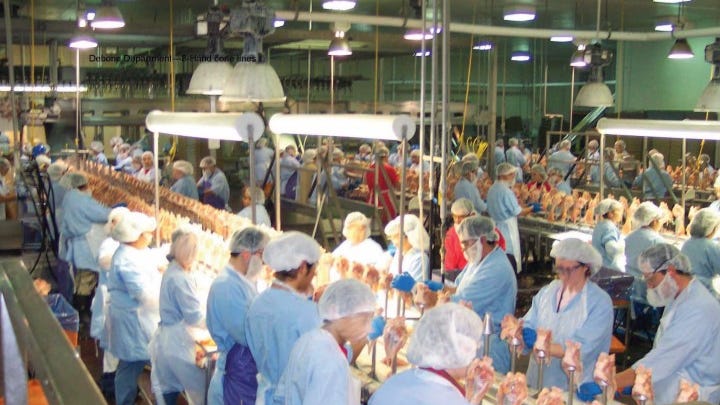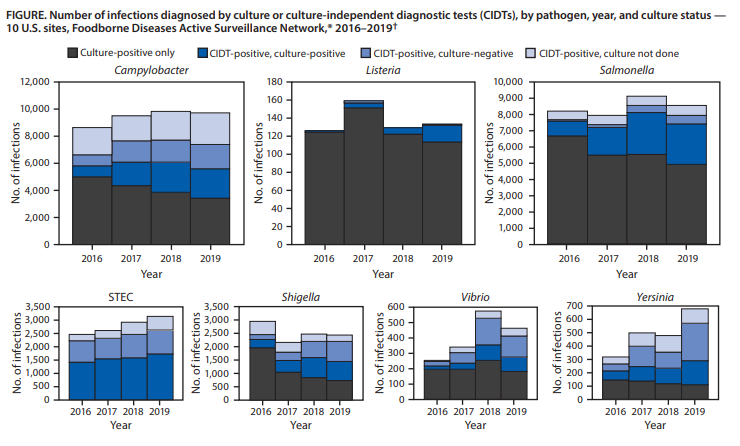The number of coronavirus cases tied to meatpacking plants passed 10,000, according to USA TODAY and Midwest Center for Investigative Reporting tracking. At least 170 plants in 29 states have had one or more workers test positive for the coronavirus. Some of those workers also have infected others, which is included in the count. At least 45 workers have died. As a result, at least 40 meat slaughtering and processing plants closed. As a result of the closures, meat shortages in some parts of the country are seen. President Trump issued an executive order to keep the plants open. At least seven coronavirus-affected meatpacking plants shut their doors since the April 28th executive order. Red meat production has shown some signs of improvement over the past week, with 46,000 more hogs and 10,000 more cattle slaughtered Wednesday than a week earlier. However, weekly production is still down 36% from the same time last year. Wendy’s, the chain restaurant, has altered its menu, and Costco has limited how much meat its customers can buy. @ https://www.usatoday.com/story/news/investigations/2020/05/06/meatpacking-industry-hits-grim-milestone-10-000-coronavirus-cases/5176342002/
ruth
At least 170 meatpacking plants in 29 states have had one or more workers test positive for the coronavirus. At least 45 workers died.
ruth
The USDA/FSIS published a report showing that Israel’s food safety inspection system governing poultry products is comparable to that of the United States. Therefore Israel can export products that are safe, wholesome, unadulterated, and correctly labeled and packaged (https://www.fsis.usda.gov/wps/wcm/connect/71282a01-258a-47f3-a5bc-36b495802c4d/Israel-2019-FAR.pdf?MOD=AJPERES). Israel exports ready-to-eat fully cooked and not shelf-stable poultry products to the United States. And those exports may continue, according to a report by the USDA’s Food Safety and Inspection Service. @ https://www.foodsafetynews.com/2020/05/israels-food-safety-inspections-found-equivalent-to-usa-for-poultry-exports/
Israel exports ready-to-eat fully cooked and not shelf-stable poultry products to the United States. And those exports may continue, according to a report
A study conducted by USDA and published in J Food Prot ((2020) 83 (5): 767–778) compared Salmonella Enteritidis levels in eggs held at 65°F versus 45°F for shell eggs and egg products. The levels of Salmonella Enteritidis in the egg products and the risk of human salmonellosis from consumption of those egg products were assessed. For eggs stored five days at 65°F (following 36 h at 75°F [23.9°C] in the layer house), the mean level of Salmonella Enteritidis contamination is 30-fold higher than for eggs stored at 45°F. These increased levels of contamination lead to a 47-fold increase in the risk of salmonellosis from the consumption of egg products made from these eggs. Assuming that 7% of the liquid egg product supply originates from eggs stored at 65°F versus 45°F, this study estimates an additional burden of 3,562 cases of salmonellosis per year in the United States. The diversion of eggs from broiler production to human consumption under the current storage practices of 65°F (versus 45°F) would present a substantive overall increase in the risk of salmonellosis. The data indicates that an early cooling and low-temperature storage of shell eggs are highly effective in reducing the level of Salmonella Enteritidis in shell eggs. @ https://meridian.allenpress.com/jfp/article/83/5/767/430558/Assessment-of-the-Risk-of-Salmonellosis-Linked-to
ruth
CDC published a report in Morbidity and Mortality Weekly Report summarizing the preliminary 2019 data and describes changes in frequency compared with that during 2016–2018 of eight pathogens (Campylobacter, Cyclospora, Listeria, Salmonella, Shiga toxin-producing Escherichia coli (STEC), Shigella, Vibrio, and Yersinia)transmitted commonly through food. The incidence of enteric infections caused the eight pathogens continued to increase or remained unchanged. The overall prevalence per 100,000 population was highest for Campylobacter (19.5), followed by Salmonella (17.1), STEC (6.3), Shigella (4.8), Cyclospora (1.5), Yersinia (1.4), Vibrio (0.9), and Listeria (0.3). Campylobacter and Salmonella caused the largest proportion of illnesses. Infections caused by Salmonella serotype Enteritidis did not decline; however, serotype Typhimurium infections continued to decrease. new strategies that target particular serotypes and more widespread implementation of known prevention measures are needed to reduce Salmonella illnesses. Reductions in Salmonella serotype Typhimurium suggest that targeted interventions (e.g., vaccinating chickens and other food animals) might decrease human infections. FoodNet surveillance data indicate that progress in controlling major foodborne pathogens in the United States has stalled. @ https://www.cdc.gov/mmwr/volumes/69/wr/pdfs/mm6917a1-H.pdf




